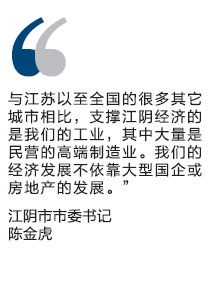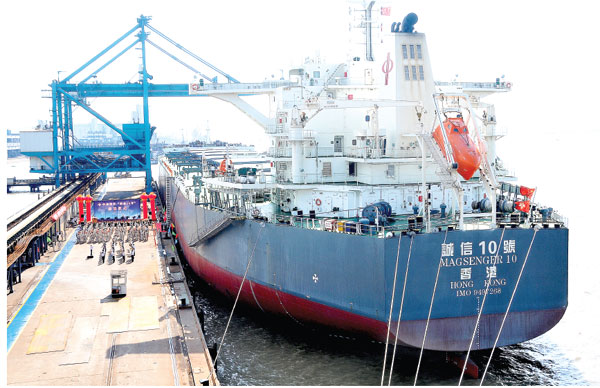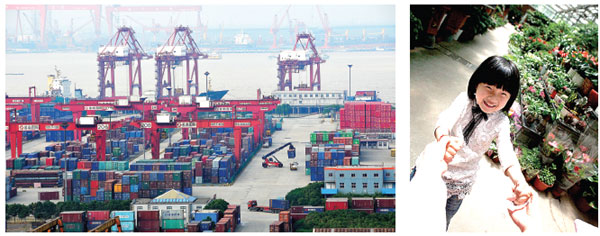Exceptional amid the 'new normal'
Jiangyin continues its seven-millennia legacy of driving the national economy
Located in the China commercial heartland of the Yangtze River Delta, Jiangyin remains a reliable engine of the national economy.
Even in "new normal" times, the Jiangsu city recorded GDP growth of 7.4 percent last year, a half percentage point ahead of the national economy.
The city, which has a population of 1.5 million but is part of the larger Jiangyin-Zhangjiagang-Jingjiang area, has been successful in upgrading its industrial sector.
It is home to 13 of China's top 500 manufacturing enterprises. Those in new emerging industries such as new energy, bio-pharmacy, now account for nearly half (42.7 percent) of total industrial output.
Services are an increasingly vital part of the local economy, now making up 43.4 percent of GDP and growing by 8 percent in 2014.
The city is also increasingly becoming a magnet for overseas direct investment, which hit $1 billion for the first time last year. This was not just from Asian concerns from Hong Kong, Taiwan, Japan and South Korea but also those from Europe and the United States also.
The city is increasingly also playing a significant role in China's national Belt and Road Initiative, aiming to network China with the rest of the world. There were seven such related investments in the city in 2015, which represents an investment of $200 million.
Xu Dongqing, director of the Jiangyin Harbour Economic Development District, says the city and the region remains a driver of development.
"Even though the national economy is slowing down, Jiangyin with its location in the Yangtze River Delta remains a driving force of the local economy," he says.
"This is the role this area has played for many decades."
One of the oldest cities in China with a 7,000-year history and with a heritage from the Wu and Chu states of the Eastern Zhou Dynasty (770-256 BC), it is strategically placed, being the first port city upstream the Yangtze River from Shanghai.
Since the Ming Dynasty (1368-1644), when the area was then the cradle of modern civilization, many leading China figures have come from the city, including the China librarian Miao Quansun and Ju Zan, a Buddhist philosopher as well as 20 academicians of the Chinese Academy of Sciences and the Chinese Academy of Engineering, more than 40 army generals and 100 presidents of universities.
Today it is a bustling metropolis with leading international hotels and many fine local restaurants, where it is always possible to try the local "Three Yangtze Delicacies" (which combines Yangtze hilsa herring, saury and balloon fish).
Chen Jinhu, secretary of the Jiangyin Party Committee of the CPC, says much of the city's recent success has been generated by the strength of local business, which have led to strong tax revenues. Fiscal revenues were 21.89 billion yuan last year.
"We have certainly not relied on auctioning land rights. This is not something we need to do. I think the days of land sales financing have gone and will never come back," he says.
"Underpinning our budgetary strength, is our industry. We have a stronger industrial base than many other cities in Jiangsu province and certainly in many other parts of China. Much of it is high-end private sector manufacturing. We are not dependent on the operations of large State-owned enterprises or real estate development."
Many of Jiangyin's most successful companies are based in the city's industrial parks and enterprise zones.
Apart from the Jiangyin Harbour Economic Development District, there is the Jiangyin National High Tech Park and the Jiangyin-Jingjiang Industrial Park.
The high tech park, which was founded in 1992, is one of China's 115 national technology parks. Much of the city's advanced manufacturing takes place on the park. Manufacturing was a major factor in the city's strong economic growth last year, contributing 55 percent, a much higher proportion than the national average where growth is being largely driven by services.
Jiangyin-Jingjiang Industrial Park, located in the south western area of the city, has become a national shipbuilding base as well as focusing on building heavy steel structures. Its achievements include building the world's largest container ship, the highest constructed steel structure and the most advanced high-speed railways cable.
The Harbour EDZ, which has ranked first among all the provincial level development zones in Jiangsu, is at the forefront of the city's Belt and Road Initiative efforts, in providing the vital infrastructure for overseas commercial ties.
The city also places a major emphasis on environmental protection and public health. It successfully achieved its 12th Five-Year Plan (2011-15) objectives with regards to achieving centralized industrial waste water treatment and monitoring of pollution sources. In public heath there have also been major improvements in hospitals and medical insurance provision.
"This is an area in which we still need to invest large sums of money so we can create more jobs in the health sector to meet the needs of our expanding population and the environment has to be a high priority," says Party Secretary Chen.
Jiangyin is not just about industry but also an attractive tourist destination. Some 15.5 million tourists visited the city last year with attractions including the Binjiang Fortress Tourist Resort.
"We have built many good public parks, sports and cultural facilities. Some of them are among the best in the country and will help us to attract more people from Shanghai and with the planned new links to the country's high-speed railway system it will take them just half an hour to get there. We will build Jiangyin into a small Shanghai," says Chen.
Zhou Furong and Xu Yan contributed to this story.
andrewmoody@chinadaily.com.cn
|
|
|
Left: At the harbour. provided to china daily Right: A little girl enjoys a greenhouse trip in Jiangyin. Gao Erqiang / China Daily |

(China Daily 07/15/2016 page27)
















